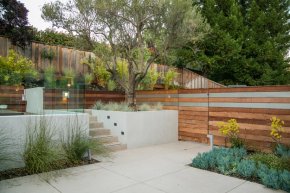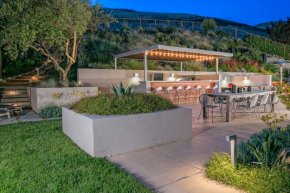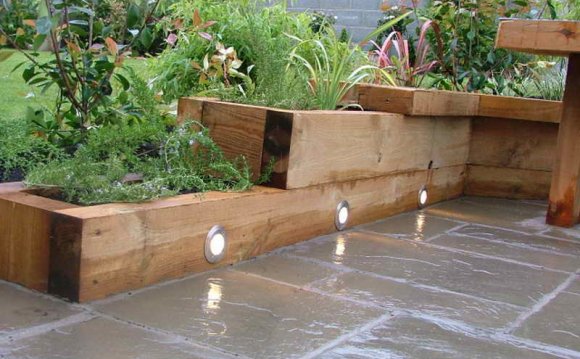
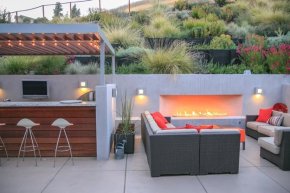 Taken to its extreme, the sleek materials and minimalist approach of modern landscaping can sometimes seem cold or uninviting. Yet modern design’s emphasis on crafting an organized space and respecting unadorned materials has the potential to create a setting which feels not only friendly and inviting, but also personalized and artful. Designer Colin Miller of Envision Landscape Studio in Walnut Creek, California, shares his tips on designing a contemporary landscape that is less space-age and more suited to the welcoming indoor-outdoor lifestyle modern gardeners are trying to create.
Taken to its extreme, the sleek materials and minimalist approach of modern landscaping can sometimes seem cold or uninviting. Yet modern design’s emphasis on crafting an organized space and respecting unadorned materials has the potential to create a setting which feels not only friendly and inviting, but also personalized and artful. Designer Colin Miller of Envision Landscape Studio in Walnut Creek, California, shares his tips on designing a contemporary landscape that is less space-age and more suited to the welcoming indoor-outdoor lifestyle modern gardeners are trying to create.
Photo by: Colin Miller.
Opt for a Natural, Loose Planting StyleNeatly organized lines of stiff, sculptural plants are the norm in many contemporary landscapes, as though the architect wanted to impose the minimalist structure of the building on the exterior spaces. Yet this type of planting style seems to utterly reject any relationship with the natural world. Miller shares a friendlier approach. “There’s no reason to feel stuck with rigid, architectural plants, ” he says. “When your plantings have a loose, alive appearance, they bring a sense of playfulness, liveliness, and warmth.”
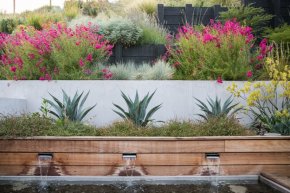 Photo by: Colin Miller.
Photo by: Colin Miller.
In a modern landscape, there is enough organization in the hardscape that you have the option to go more natural in the plantings. “You don’t see a lot of perennials in modern gardens, and I’m not sure why that is, ” says Miller. “The flower color warms things up a lot, and combines well with the color from ornamental grasses. Perennials can get a little loose and messy looking, so you need to use them very strategically, but they can really soften a corner or a walkway.”
Use Plants to Connect Your Garden With Its SurroundingsPlants with bold silhouettes have a clean look which feels appropriate next to the architecture. “We start with an organized palette in and around the outdoor rooms, then as we go farther out, we want the plantings to almost dissolve into the surrounding natural environs, ” explains Miller. “In our area the gardens often have beautiful backdrops, sometimes overlooking golden California hills, or a riparian area near a creek.”
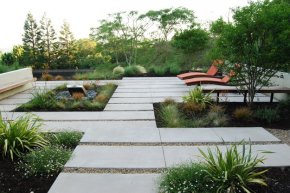 He designs the outer edges of the planted areas almost as one would weave a tapestry, creating a loose fabric of textures and colors which blurs the boundary lines of the landscape and visually claims the scenery beyond. Near a riparian zone, he pulls in rushes and other fresh, lush plants. Next to grassland, he draws upon the motion and softness of ornamental grasses. “We never want a landscape to feel like a sterile museum, ” he says.
He designs the outer edges of the planted areas almost as one would weave a tapestry, creating a loose fabric of textures and colors which blurs the boundary lines of the landscape and visually claims the scenery beyond. Near a riparian zone, he pulls in rushes and other fresh, lush plants. Next to grassland, he draws upon the motion and softness of ornamental grasses. “We never want a landscape to feel like a sterile museum, ” he says.
Photo by: Huettl Landscape Architecture.
Bring Warmth to Your HardscapesA sterile, lifeless appearance is a common pitfall in modern design. There’s an emphasis on the use of “honest” materials, which is to say they aren’t pretending to be something they are not. For example, a simple concrete patio is more honest than is concrete that has been stamped and colored to look like flagstone. Yet as Miller points out, “the natural colors of concrete, steel, smooth stucco, and some types of stone have a cool appearance which can be uninviting if overused. The obvious solution is to add color, but color can take you away from a modern aesthetic.”
